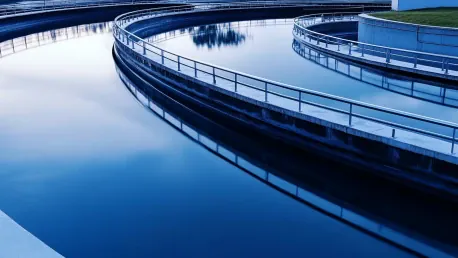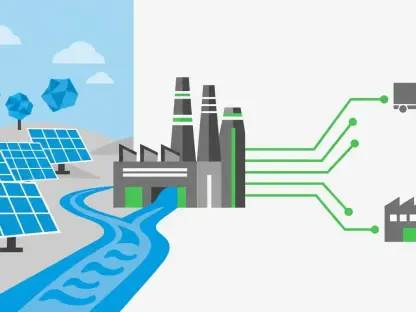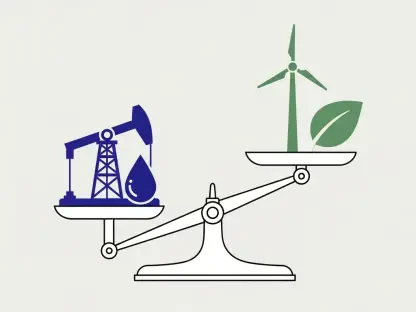The advancement of clean energy technologies often hinges on the efficiency of specific components within these systems. Anion exchange membranes (AEMs) are essential for their roles in devices like fuel cells and redox flow batteries. Traditional thinking suggested that maintaining high water levels in AEMs was crucial for optimal ion transport, but new research turns this belief on its head. New findings offer groundbreaking insights into optimized water usage in AEMs, leading to more durable, efficient, and practical clean energy solutions.
Rethinking Water Usage in Ion-Conducting Membranes
Paradigm Shift in AEM Efficiency
Recent groundbreaking research from the University of Chicago Pritzker School of Molecular Engineering and the Tandon School of Engineering of New York University has provided a fresh perspective on the water content necessary for efficient AEM function. By focusing on the structure and quality of the water network rather than sheer volume, researchers have unlocked new possibilities for enhancing AEM efficiency. High levels of free-flowing water, often thought essential, have adverse effects such as weakening the membrane’s integrity over time and posing challenges in low-humidity environments. This new research reveals that the key lies in maintaining a structured water network rather than focusing solely on quantity.
This innovative approach integrates simulations and experimental data, constructing a detailed depiction of how ions interact within the AEMs. The findings elucidate that only a sufficient quantity of water is necessary, provided it organizes into well-structured networks. This structural integrity fosters efficient ion movement, overturning the traditional belief that excess water is required. This paradigm shift underscores the critical role of molecular interactions and dynamics within the membrane, opening avenues for future advancements in clean energy technologies.
The Role of Structured Water Networks
Water plays an essential role in aiding the movement of ions within AEMs, but it’s not the quantity but the structured networks of water molecules that truly drive efficiency. These conclusions were drawn from integrating simulations with experimental data, revealing a comprehensive picture of how ions interact within the membranes. Structured water networks create an environment conducive to efficient ion transport by forming hydrogen bonds that serve as channels. When water molecules are optimally arranged, they form a dynamic shell around the ions, facilitating smooth conduction while maintaining membrane stability.
In-depth studies using techniques such as two-dimensional infrared spectroscopy (2D IR) and molecular simulations have provided precise models capturing the fast dynamics of water within the membranes. The absorbed water molecules create networks of hydrogen bonds, functioning as conduits for ion movement. This optimal structuring significantly reduces the energy required for ion transfer, making AEMs more efficient even with reduced water content. The structural integrity of these networks ensures lasting efficiency, challenging preconceived notions about the necessity of high water volumes.
Detailed Insights from Research
Interactions of Ions and Molecules
The study sheds light on the intricate dance between negatively charged anions, positively charged cations, and water molecules. Embedded positively charged molecules in AEMs attract anions and repel cations, creating the vital charge differences necessary for various electrochemical reactions. Maintaining structured water networks ensures these interactions occur efficiently. Researchers mapped out these interactions using advanced techniques, combining theoretical simulations with practical experiments to visualize the dynamic behavior of water and ions within the membranes. This detailed understanding of molecular dynamics allows for optimizing AEM design and functions, making them more adaptable to varying conditions.
A critical aspect of this research lies in recognizing that the positively charged areas within AEMs attract anions while repelling cations, thus forming essential charge gradients. These gradients drive electrochemical processes such as converting chemical energy into electricity or splitting water to produce clean fuel. Structured water networks support these processes by providing well-defined pathways for ion movement, reducing the resistance and energy required for ion transport through the membrane. This insight transforms our approach to designing AEMs, prioritizing molecular structuring over water abundance.
Challenging the Need for Excess Water
Historically, a high volume of free-flowing water within AEMs was considered necessary for speedy ion transport. However, excessive water can weaken membrane structures and limit device performance in low-humidity environments. Contrary to this belief, the study demonstrates that only sufficient amounts of water are required for optimal ion transport, provided the water forms well-organized networks. This finding challenges long-held scientific convictions about water content in ion-conducting membranes, presenting a nuanced view of how water molecules contribute to membrane efficiency.
Maintaining well-structured water networks ensures efficient ion movement while preserving membrane integrity. Researchers found that the hydrogen bonds within the water networks facilitate smooth ion transfer, reducing the energy required and maintaining high conductivity. This revelation signifies that the focus should shift from maximizing water volume to optimizing water distribution and structuring within the membranes. Engineers and scientists can now re-evaluate their approach to AEM design, incorporating these insights to enhance the performance and durability of electrochemical devices.
Technological Implications
Engineering Next-Generation AEMs
The study marks a significant shift in how AEMs should be designed. Engineers now have a molecular-level guide to optimize water content within AEMs, potentially leading to more durable and efficient membranes that function well even in low-humidity conditions. This insight could revolutionize the development of various clean energy technologies. By harnessing structured water networks, next-generation AEMs can maintain high ion conductivity without the drawbacks associated with excessive water. This optimization can lead to membranes that are not only efficient but also robust and long-lasting, expanding their applicability across different environments and applications.
Considering these new insights, the design standards for AEMs can evolve to prioritize water structuring over quantity. Engineers can leverage the detailed molecular models provided by the research to fine-tune water levels and distribution within the membranes, ensuring optimal performance under diverse conditions. This paradigm shift has the potential to enhance the practicality and efficiency of clean energy devices, making them more accessible and viable for widespread adoption. By refining AEM design based on these findings, we stand on the brink of significant advancements in fuel cells, batteries, and other clean energy solutions.
Broader Applications and Methodologies
By employing advanced techniques like two-dimensional infrared spectroscopy (2D IR) and molecular simulations, researchers have not only addressed the specifics of AEM efficiency but also established a powerful framework for exploring molecular dynamics in other scientific problems. This approach could inspire further innovations across different technological fields. The strategic combination of experimental and simulation data sets a precedent for investigating similar systems, opening doors to advancements in materials science, biochemistry, and other domains where molecular interactions play a pivotal role.
These methodologies provide a clear blueprint for future research, offering precise and dynamic models of molecular behavior applicable to various challenges. As scientists and engineers delve into the intricate dynamics of different systems, the principles and techniques developed here can serve as a foundational guide. Understanding the importance of structured networks extends beyond AEMs, suggesting new ways to optimize other materials and systems for enhanced performance. This research not only advances the field of clean energy technology but also contributes valuable insights to broader scientific endeavors.
Looking Ahead
Redefining Design Standards
Understanding the importance of structured water networks over high water volumes presents new design standards for AEMs in clean energy devices. This paradigm shift underscores the need to prioritize molecular structure and dynamics, potentially enhancing the performance and practicality of fuel cells, batteries, and other energy storage systems. The implications of this research extend to the overall efficiency and durability of clean energy solutions, suggesting that refined, molecular-level strategies can yield substantial improvements.
Future developments in AEM technology will likely focus on fine-tuning water structuring, leveraging the insights from this study to create more adaptable and efficient membranes. Engineers and scientists can employ these principles to redefine performance metrics, ensuring that water levels and distribution are optimized based on detailed molecular models. This evolution in design standards holds promise for more resilient and effective clean energy devices, capable of operating efficiently under varying environmental conditions. These advancements can contribute to the broader goal of achieving sustainable and practical energy solutions, driving progress in the clean energy sector.
A New Era for Clean Energy Technology
The development of clean energy technologies frequently depends on the efficiency of specific components within these systems. A crucial component in such technologies is the anion exchange membranes (AEMs), which play a vital role in devices like fuel cells and redox flow batteries. Historically, it was believed that maintaining high water levels in AEMs was essential for optimal ion transport. However, recent research has challenged this conventional wisdom. The latest findings reveal groundbreaking insights into how optimized water usage in AEMs can lead to more durable, efficient, and practical clean energy solutions. These discoveries not only propose a shift in how we understand AEM hydration but also promise significant advancements in the performance and longevity of clean energy devices. This new understanding could redefine the design and operation of future clean energy systems, ultimately contributing to a more sustainable and energy-efficient future.









